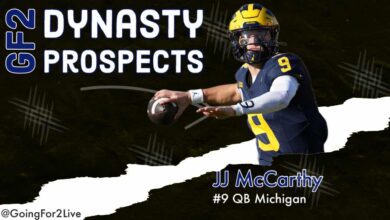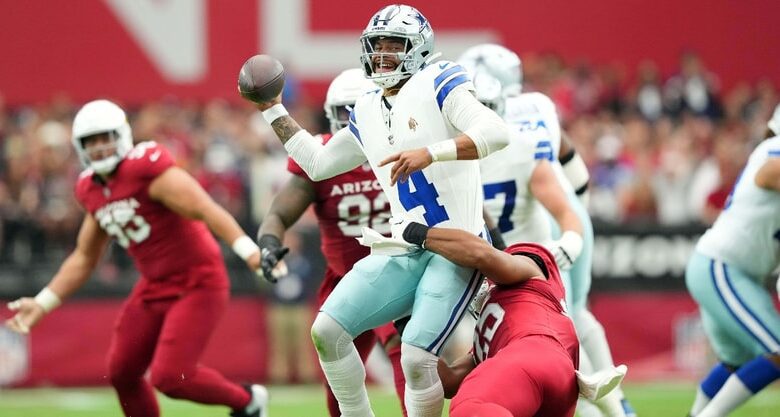
I can’t believe it’s already Week 4. That means it’s high time to start erasing pre-season takes from your mind and focus on actual 2023 production. For example, coming into Week 3, I cut David Njoku from my home-league roster that only has four bench spots (an insanely small number, I know). Njoku had a lot of hype this pre-season. He was the best player in Browns camp and they were going to use him in all sorts of unique ways like jet sweeps. It hasn’t happened so far this season. He’s averaging just shy of 4 targets per game with a very low average depth. I don’t know why the Browns aren’t using their very athletic TE down the field, but they aren’t. So, in response, I cut Njoku for a player whose next game is this upcoming Thursday.
Sam LaPorta: Top 5 TE
Narrator: That worked out.
Rookie TEs have historically been poor bets in fantasy football. The narrative is that TEs effectively play both offensive line and receiver, and learning both positions takes time. Sam LaPorta has bucked that trend so far. His 18 receptions through 3 games are the most by any rookie TE since 2006. He’s currently on pace to break the rookie TE record for receptions in a season.
The below graph shows targets per route run (TPRR) on the x-axis and route rate on the y-axis. You’ll notice Sam LaPorta all the way to the right, behind only Travis Kelce and Jake Ferguson in TPRR. The issue for LaPorta (and also Ferguson) is his route rate. In terms of total routes run, LaPorta is 18th among TEs (Ferguson is 31st). We’ll want LaPorta’s routes to increase throughout the season, and I’m betting his talent and production thus far help his case.

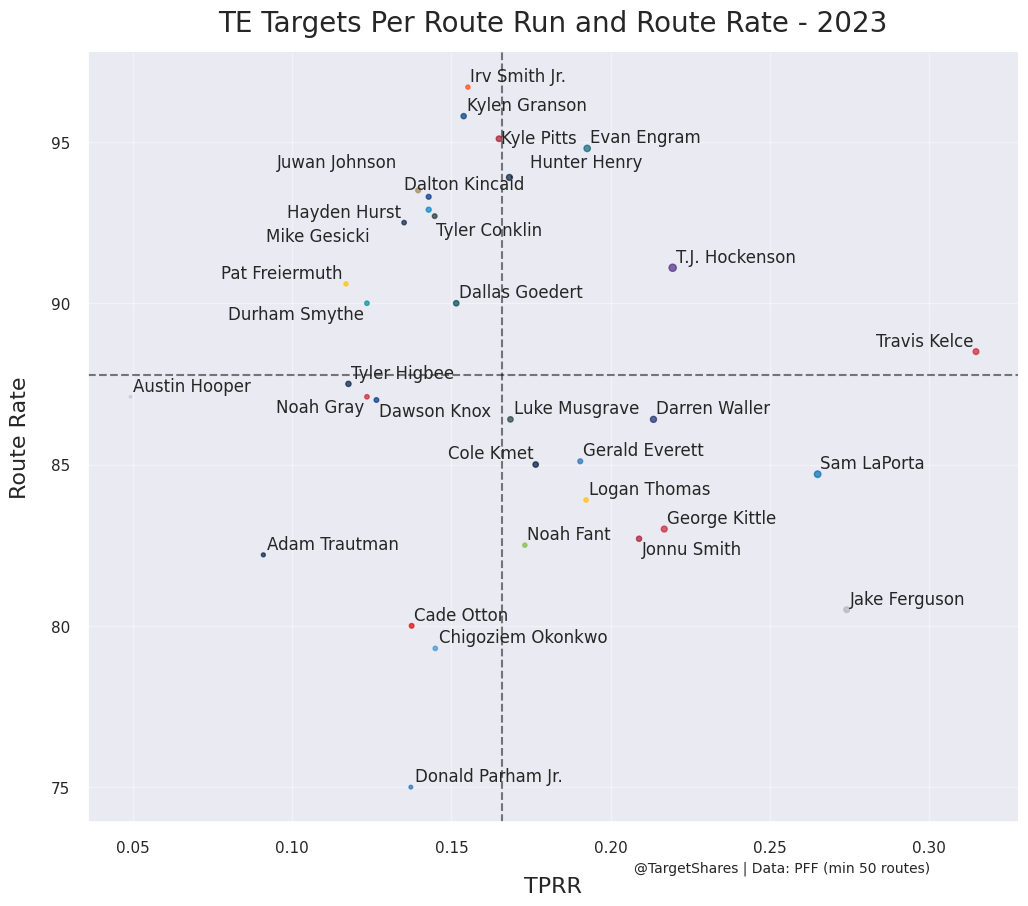
Khalil Herbert: Split Backfield in the League’s Worst Offense
Speaking of pre-season takes, I was high on Khalil Herbert coming into the season. He was first in the league in rushing yards over expected (RYOE) in 2022. The idea was that level of efficiency, combined with the Bears’ offense taking a step forward, could make Khalil a great value at ADP. Unfortunately, the Bears’ offense has taken a rather large step in the opposite direction.
The graph below shows RYOE on the x-axis and success rate on the y-axis from NFL Next Gen Stats. Khalil Herbert is at the top of the graph. His RYOE has dropped back to an average level though he does lead the league in Next Gen Stats’ version of success rate. Combine that with being a member of the Bears in 2023 and splitting time with Roschon Johnson, it seems like there are probably better options on waivers at this point.
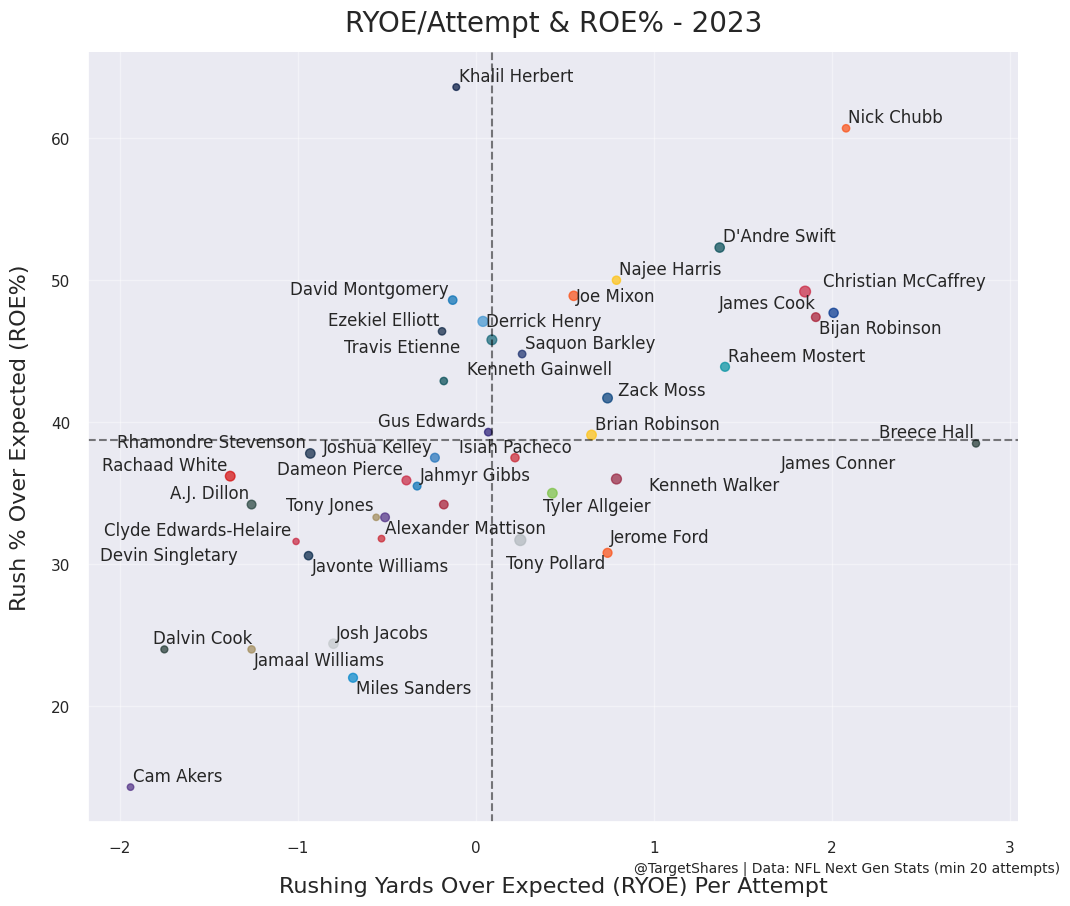
AJ Dillon: Wrong Even When You’re Right
Continuing with a similar theme, it’s important to think about the range of outcomes for players, particularly RBs, that you’re stashing on your bench. AJ Dillon isn’t the perfect example of this but I still think he’s illustrative. The upside for backup RBs is that if the starter goes down, their snap share and opportunities could spike. It’s impossible to be sure of that but you can often gain some insight by looking at similar situations in the past.
When Aaron Jones missed 2 games in 2021, AJ Dillon’s snap share jumped from 40% to 63%, or an increase of 23 percentage points. Unfortunately, AJ Dillon managers haven’t enjoyed that same spike in 2023. AJ Dillon’s snap share has only increased by eight percentage points in Weeks 2 and 3 of this year despite Aaron Jones missing time. Additionally, AJ Dillon is in the bottom five in RYOE per attempt. So, his opportunity barely increased with Jones missing time and he’s underwhelmed on those attempts.
The more general point here is to make sure that you’re not stashing a player on your bench that even when the starter gets hurt, they still won’t get a substantial boost in opportunities. It’s really hard to know this, especially in a situation like Dillon’s where we have a past trend pointing to an expected increase. But in most situations, you can see how snaps are split after the starter. Be particularly wary when those snaps are not consolidated or you have talent questions about the backup.
Packers’ Second-Half Adjustments
Continuing with the Packers, I talked last week about how Jordan Love’s TD rate was unsustainable, particularly when factoring in his poor completion percentage over expectation (CPOE). We started to see that trend reverse in Week 3, where Love threw just one touchdown pass. Yet, I was impressed by the second-half adjustments from the Packers against one of the best defensive units in the league.
The Packers switched to the empty formation a lot after halftime, with only one empty look in the first half but ten in the second half. Despite being in Empty, the Packers did a good job adjusting protections and picking up blitzes. Two of their biggest plays of the game (both 30-yard passes) were from empty, leading their EPA/play to hit 0.20 in empty vs. 0.03 in other formations. I’m still skeptical of Love since he remains last in CPOE but it was a good second half from the Packers.
Jaguars: Too Early to Panic
Despite the 20-point loss to the Texans, I still don’t think it is time to panic about the Jaguars’ offense. The main problem in my view has been their lack of success on high-leverage plays. The graph below shows passing EPA per play on the x-axis and rushing EPA per play on the y-axis. And I’ve limited the graph to only offensive plays on 3rd and 4th downs. The Jaguars are exactly where you don’t want to be, which is the bottom-left of the graph. They are last in the league in rushing EPA on 3rd and 4th downs and third-to-last in passing EPA. A lot of this can be written off as a still-small sample size. There are some justifiable questions about play-calling, especially since Doug Pederson turned over those duties to Press Taylor at the start of the season. But Trevor Lawrence is not playing poorly so it’s still too early to panic.
Love our content? Check out the GoingFor2 Live Podcast Network!
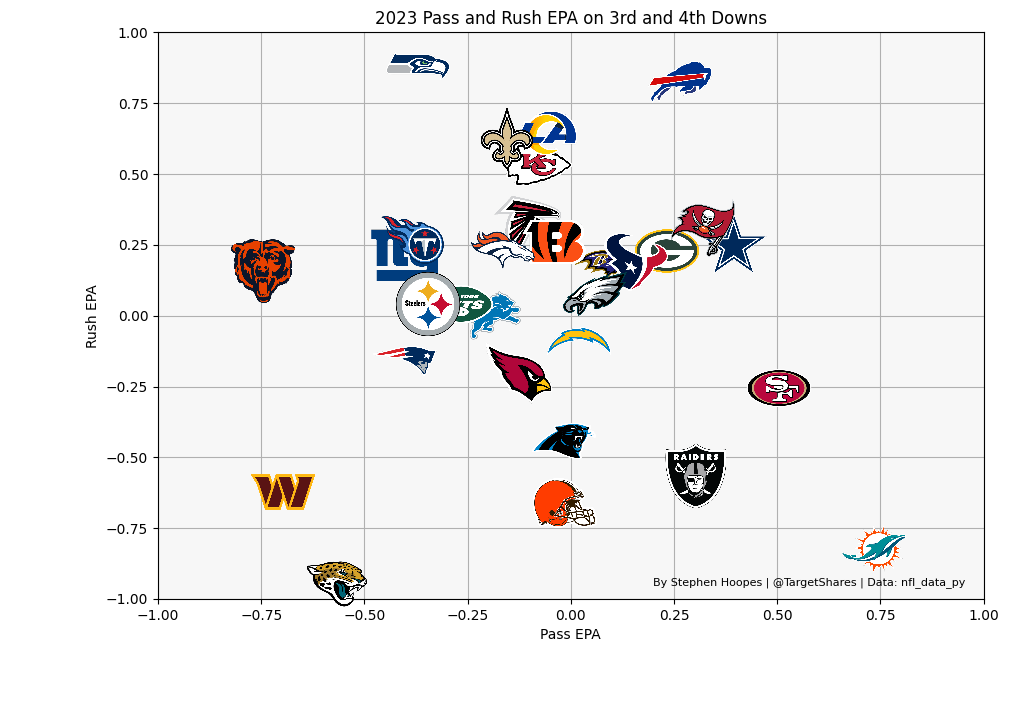
Lamar Jackson: Faster Throws and Less Pressure
The Ravens offense hasn’t lived up to the pre-season hype quite yet. For example, Lamar Jackson is hovering around the league average in EPA per dropback. Yet, some peripherals provide some optimism. The graph below shows both Lamar’s average time to throw and pressure rate by season. You’ll notice substantial drops in both vs. Lamar’s career numbers. Lamar is getting the ball out to his weapons faster, particularly with designed looks to Zay Flowers. I do think there is reason to hope that Todd Monken’s offense and their improved WRs can propel the Ravens’ offense in future weeks. This is especially true if they can combine this quick time to throw with deeper passes, which is something the Dolphins have excelled in so far this year.
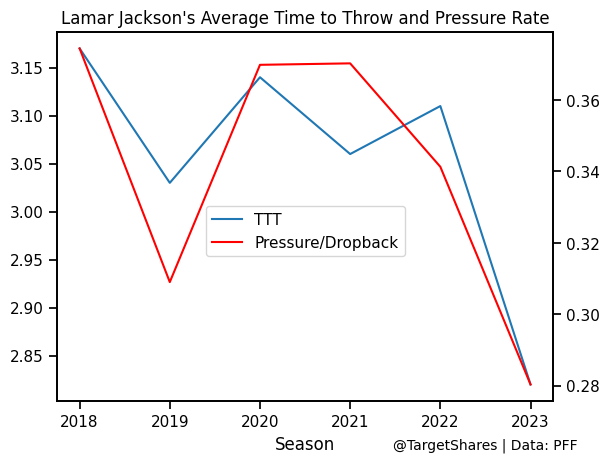
Brock Purdy: Grounded
I brought up in last week’s edition that the 49ers were 8th in the league in air yards per pass attempt. On Thursday night, Brock Purdy turned around and generated 95% of his completion EPA from yards after the catch (YAC). In one game, the 49ers dropped from 8th to 22nd in air yards per pass attempt. It’s truly a credit to Shanahan and the 49ers’ skill players that they were able to beat the Giants by 18 points despite relying almost exclusively on YAC. Here’s hoping Aiyuk’s return to the lineup inspires some more down-the-field passing.
Wan’Dale Robinson: Another TPRR Monster
Speaking of that Thursday night game, Wan’Dale Robinson joins the list of one of my favorite player archetypes: WRs that earn a lot of targets on a small number of routes. Hope springs eternal with these guys. Wan’Dale ran only 9 routes in the game versus the 49ers but earned targets on a massive 5 of them. That includes 3 targets on 3rd down plays. He’s not playable with that low of a snap share, but he’s a player who has a history of earning targets and has flashed that ability in his first action of the season. Make sure he’s at least on your watchlist.
Joshua Palmer vs. Quentin Johnston: Thinking Long-Term
I mentioned last week that Joshua Palmer was still ahead of first-round rookie Quentin Johnston on the Chargers’ depth chart. Yet, Palmer is not someone who has performed very well on the season. It’s not a massive bar for Johnston to get over. This battle comes into particular focus after Mike Williams’ unfortunate season-ending injury in Week 3. If you’re in a short-term bind, I do think Palmer will continue to outscore Johnston in the coming weeks. However, Johnston is the big-win, riskier bet. We hardly have any sample size on Johnston to be confident he exceeds in year 1. But compared to Palmer, he has the advantage of the unknown. Take the swing on Johnston if you can as he has the better odds to be a difference-maker in the fantasy playoffs. Especially when Herbert is doing stuff like this:

I Feel Like I Have to Talk about the Dolphins
I’m sure you’ve read enough about the Dolphins’ 70-point performance by now. But c’mon I have to talk about it, right? I’ve talked about the Dolphins’ creative use of motion in previous editions, and they again had pre-snap motion on 49 of their offensive snaps in Week 3. The five fastest recorded speeds on the season all belong to the Dolphins according to NFL Next Gen Stats (Achane twice, Tyreek twice, and Mostert once). The ability of the Dolphins to weaponize their speed is must-watch TV. One small niche note to look out for is Julian Hill seems to have surpassed Durham Smythe on the TE depth chart. I’m going to be honest; I had never heard of Julian Hill prior to this week. But he ran only two fewer routes than Tyreek Hill in the game. He only earned one target, which leaves a lot to be desired, but if you’re looking for free pieces on this offense, Julian Hill at least should be on your watchlist. It also means you need to drop Durham Smythe.
ATTN Dynasty Commissioners: Do you want to do something cool for your league? How about a 1-hour live show dedicated to YOUR league? Team-by-team breakdowns, rankings, and more. For details and to book a show, visit: GoingFor2.com/plp.






